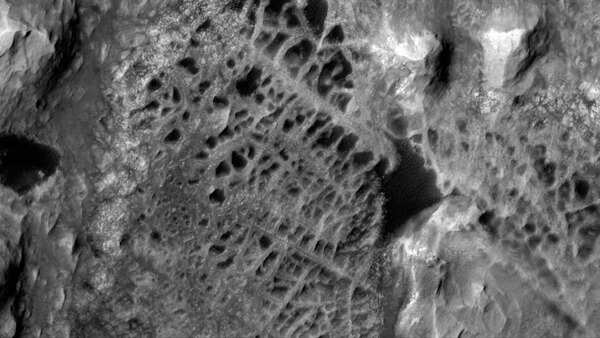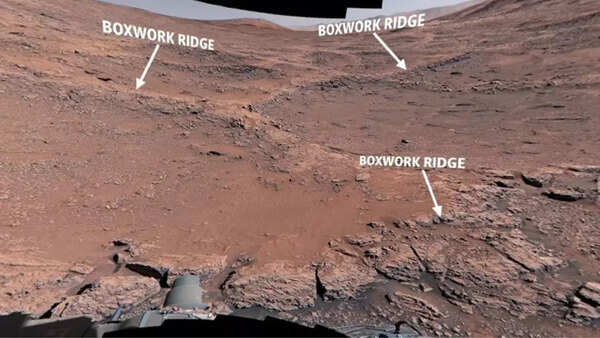NASA's Curiosity rover has delivered the first close-up images of unusual, spiderweb-like rock structures on the Martian surface. These formations may offer valuable insights into the planet's ancient history and potential for past life.
The intricate, zig-zagging features, referred to as “boxwork,” were discovered on the slopes of Mount Sharp within Gale Crater, the area Curiosity has been exploring since 2012. The mineral-rich ridges are thought to have been created by ancient groundwater activity, resembling delicate webs when viewed from above. Scientists are hopeful that these formations will provide crucial information about Mars' capacity to support microbial life in the distant past.

Despite their arachnid-inspired nickname, these structures aren't the work of Martian insects. They are geological formations called boxwork, characterized by intersecting mineral ridges. These patterns arise when groundwater flows through cracks in the rock, leaving behind mineral deposits. Over extended periods, wind erosion removes the surrounding softer rock, exposing the hardened, web-like framework beneath.
While boxwork formations have been observed from orbit, this is the first time they have been examined in detail on the surface of Mars. Curiosity reached this location in early June 2025, after several months of traversing Mount Sharp. NASA released the images, along with a 3D interactive video of the formations, on June 23, highlighting their unique structure and unexplained location as a key scientific priority.

Analysis of the surrounding rocks reveals veins of calcium sulfate, a salty mineral commonly deposited by groundwater. These findings suggest that the area was once abundant in liquid water, creating an underground environment that may have been warm and salty – potentially conducive to microbial life, similar to conditions on early Earth.
It's important not to confuse the newly imaged boxwork formations with the "spiders on Mars," which are dark, radial patterns caused by carbon dioxide ice erupting from beneath the surface. Unlike these seasonal features, boxwork is permanent and mineral-based, resulting from geological processes rather than atmospheric activity.
Scientists speculate that these formations could contribute to resolving the question of whether Mars once supported life. The mineral composition, protected underground environment, and evidence of flowing water all suggest an environment that could have sustained microbial organisms. As Kirsten Siebach, a Curiosity mission scientist, noted, “Early Earth microbes could have survived in a similar environment.”
Curiosity will continue its investigation of this boxwork patch on Mount Sharp, collecting samples through drilling and conducting comprehensive chemical analyses. Researchers are hopeful that these unique structures will not only shed more light on Mars' climate history but also guide future missions in the search for signs of life beneath the Martian surface.
Newer articles
Older articles
 India Enters New Space Age as Astronaut Shukla Joins ISS Mission
India Enters New Space Age as Astronaut Shukla Joins ISS Mission
 X Cracks Down: Half a Million Indian Accounts Suspended for Policy Breaches
X Cracks Down: Half a Million Indian Accounts Suspended for Policy Breaches
 Google Unveils Strategy to Combat Misinformation, Boost Voter Access in India's 2024 Elections
Google Unveils Strategy to Combat Misinformation, Boost Voter Access in India's 2024 Elections
 Hair Oil vs. Hair Serum: Which is the Right Choice for Your Hair?
Alternatively:
Unlock Your Best Hair: Choosing Between Hair Oil and Serum for a Healthy Mane
Hair Oil vs. Hair Serum: Which is the Right Choice for Your Hair?
Alternatively:
Unlock Your Best Hair: Choosing Between Hair Oil and Serum for a Healthy Mane
 Bollywood's 'Swades' Anthem Joins Axiom-4 Mission: Indian Astronaut's Playlist Honors Heritage in Space
Bollywood's 'Swades' Anthem Joins Axiom-4 Mission: Indian Astronaut's Playlist Honors Heritage in Space
 Vijay Sethupathi Apologizes Amid Controversy Over Son's Film 'Phoenix'
Vijay Sethupathi Apologizes Amid Controversy Over Son's Film 'Phoenix'
 New York Assemblyman Zohran Mamdani's Style: 5 Lessons in Authenticity and Heritage
New York Assemblyman Zohran Mamdani's Style: 5 Lessons in Authenticity and Heritage
 Colon Cancer: Don't Ignore These 5 Early Warning Signs
Colon Cancer: Don't Ignore These 5 Early Warning Signs
 TSMC Regains Top 10 Global Value Ranking Amid AI Boom
TSMC Regains Top 10 Global Value Ranking Amid AI Boom
 Android Users Urged to Update Devices Amid High-Severity Security Flaws: Government Issues Warning
Android Users Urged to Update Devices Amid High-Severity Security Flaws: Government Issues Warning